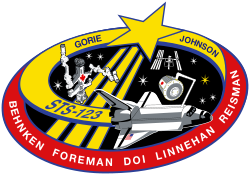Takao Doi
| Takao Doi | |
|---|---|
 | |
| Land | Japan |
| Organisation | JAXA |
| ausgewählt | 7. August 1985 (1. NASDA-Gruppe) |
| Einsätze | 2 Raumflüge |
| Start des ersten Raumflugs | 19. November 1997 |
| Landung des letzten Raumflugs | 27. März 2008 |
| Zeit im Weltraum | 31d 9h 45m |
| EVA-Einsätze | 2 |
| EVA-Gesamtdauer | 12h 42m |
| ausgeschieden | 13. September 2009 |
| Raumflüge | |
Takao Doi (jap.土井 隆雄, Doi Takao; * 18. September 1954 in Landkreis Süd-Tama (heute Stadt Machida), Präfektur Tokio, Japan) ist ein ehemaliger japanischer Astronaut. Er war der erste Japaner, der einen Außenbordeinsatz unternahm.
Takao Doi erhielt 1978 von der Universität Tokio einen Bachelor in Luftfahrttechnik, 1980 einen Master in Ingenieurwesen und promovierte 1983 in Luft- und Raumfahrttechnik. Außerdem promovierte er 2004 an der Rice University über Astronomie.
Von Doi stammen über 40 Veröffentlichungen aus den Bereichen chemische und elektrische Antriebssysteme, Flüssigkeitsdynamik, Schwerelosigkeitswissenschaften sowie Astronomie.
Takao Doi studierte Raumfahrt-Antriebssysteme als Forschungsstudent im Institute of Space and Astronautical Science in Japan von 1983 bis 1985. Er arbeitete 1985 für das Lewis Research Center der NASA als Forschungsmitglied des National Research Council.
Doi trat 1985 der japanischen Raumfahrtagentur NASDA (National Space Development Agency) bei und hat seitdem im japanischen bemannten Raumfahrtprogramm gearbeitet. Von 1987 bis 1988 betrieb er Forschungen im Bereich der Flüssigkeitsdynamik in Schwerelosigkeit an der University of Colorado und 1989 als Gast-Wissenschaftler am National Aerospace Laboratory in Japan.
Astronautentätigkeit
1992 war er Ersatz-Nutzlastspezialist für die japanische Spacelab-Mission STS-47. 1994 arbeitete er als Projektwissenschaftler an der International-Microgravity-Laboratory-2-Mission STS-65.
STS-87
Am 19. November 1997 startete Doi mit der Raumfähre Columbia als Missionsspezialist zum ersten Mal ins All. STS-87 war ein Spacelab-Flug, der die Bezeichnung „United States Microgravity Payload 4“ trug. Dabei führte Doi mit dem Missionsspezialisten Winston Scott zwei Weltraumausstiege (EVAs) durch. Bei der ersten EVA fingen sie den zu Beginn des Fluges ausgesetzten Forschungssatelliten SPARTAN ein, der in ein unkontrolliertes Taumeln geraten war. Außerdem erprobte man erstmals die sogenannte AERCam, eine etwa 40 Zentimeter große Kugel, die mit einem Lageregelungs- und einem Kamerasystem ausgestattet, schwer zugängliche Strukturen erkunden kann. Scott ließ ihn aus der Nutzlastbucht schweben und der Pilot Steven Lindsey kontrollierte AERCam mittels Fernbedienung vom Cockpit aus. Am 5. Dezember landete das Space Shuttle am Kennedy Space Center.
STS-123
Doi war Missionsspezialist auf dem STS-123-Flug, der im März 2008 das erste Teilstück des japanischen Kibō-Moduls und die kanadische Roboterhand Dextre zur Internationalen Raumstation brachte.
Weitere Karriere
Im September 2009 begann Doi bei der UN-Agentur Büro der Vereinten Nationen für Weltraumfragen (UNOOSA) zu arbeiten.
Privates
Doi ist mit Hitomi Abe verheiratet.
Siehe auch
Weblinks und Belege
- JAXA: Takao Doi (Ph.D.) Biografie (englisch)
- spacefacts.de: Kurzbiografie
| Personendaten | |
|---|---|
| NAME | Doi, Takao |
| ALTERNATIVNAMEN | 土井 隆雄 (japanisch) |
| KURZBESCHREIBUNG | japanischer Astronaut |
| GEBURTSDATUM | 18. September 1954 |
| GEBURTSORT | Minamitama-gun, Präfektur Tokio |
Auf dieser Seite verwendete Medien
The STS-87 patch is shaped like a space helmet symbolizing the Extravehicular Activity (EVA) on the mission in support of testing of tools for the assembly of the International Space Station (ISS). Earth is shown reflected on the backside of the helmet. The Space Shuttle Columbia forms the interface between the Earth and the heavens, the back and front sides of the helmet in profile. The three red lines emerging from Columbia represent the astronaut symbol as well as the robot arm, which was used to deploy and retrieve the Spartan satellite.
The text 'µg' represents the payloads studying microgravity science in space on this United States Microgravity Payload (USMP-4) mission. Gold flames outlining the helmet visor represent the corona of the Sun, which will be studied by Spartan. The flag of Ukraine is next to the name of the payload specialist who is the first person from that nation to fly on the Space Shuttle.
STS-123 continues assembly of the International Space Station (ISS). The primary mission objectives include rotating an expedition crew member and installing both the first component of the Japanese Experimental Module (the Experimental Logistics Module - Pressurized Section (ELM-PS)) and the Canadian Special Purpose Dexterous Manipulator (SPDM). In addition, STS-123 will deliver various spare ISS components and leave behind the sensor boom used for inspecting the shuttle's thermal protection system. A follow-on mission to ISS will utilize and then return home with this sensor boom. A total of five spacewalks are planned to accomplish these tasks. The mission will also require the use of both the shuttle and ISS robotic arms. STS-123 will utilize the Station-Shuttle Power Transfer System to extend the docked portion of the mission to eleven days, with a total planned duration of 15 days. The crew patch depicts the space shuttle in orbit with the crew names trailing behind. STS-123's major additions to ISS (the ELM-PS installation with the shuttle robotic arm and the fully constructed SPDM) are both illustrated. The ISS is shown in the configuration that the STS-123 crew will encounter when they arrive.


